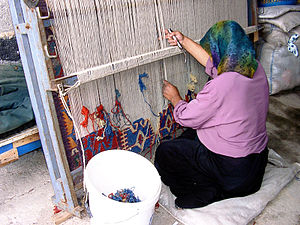Stående vävstol
| Den här artikeln behöver källhänvisningar för att kunna verifieras. (2017-08) Åtgärda genom att lägga till pålitliga källor (gärna som fotnoter). Uppgifter utan källhänvisning kan ifrågasättas och tas bort utan att det behöver diskuteras på diskussionssidan. |
Stående vävstol, en vävstol med lodrät spänd varp, var en av de första slags vävstolar som användes för att åstadkomma tyg. De finns dokumenterade sen långt före vår tideräkning, och användes fram till 1700-talet i Skandinavien då golvvävstolen (i vissa fall kallad trampvävstol) nådde oss i större omfattning. Det finns flera olika typer av stående vävstolar, bland annat varptyngd väv och vissa typer av rundvävar.
Externa länkar
Vävning i modern tid i varptyngd vävstol
| ||||||||||||||||||||||||||||
Media som används på denna webbplats
Författare/Upphovsman: Tkgd2007, Licens: CC BY-SA 3.0
A new incarnation of Image:Question_book-3.svg, which was uploaded by user AzaToth. This file is available on the English version of Wikipedia under the filename en:Image:Question book-new.svg
Författare/Upphovsman: Randy Oostdyk, Licens: CC BY-SA 3.0
Stående vävstol i bruk, från Turkiet
Författare/Upphovsman: Internet Archive Book Images, Licens: No restrictions
Identifier: studiesinprimiti00roth (find matches)
Title: Studies in primitive looms
Year: 1918 (1910s)
Authors: Roth, H. Ling (Henry Ling), 1854-1925 Royal Anthropological Institute of Great Britain and Ireland. Journal
Subjects: Weaving
Publisher: Halifax (Eng.) F. King & sons, ltd
Contributing Library: Sterling and Francine Clark Art Institute Library
Digitizing Sponsor: Sterling and Francine Clark Art Institute Library
View Book Page: Book Viewer
About This Book: Catalog Entry
View All Images: All Images From Book
Click here to view book online to see this illustration in context in a browseable online version of this book.
Text Appearing Before Image:
otiya loom, which I saw at work at the Coronation Exhibition inLondon in 1910, is now likewise in Bankfield Museum, and is fitted up for makingrugs or pile cloth. It is provided with a ball of weft instead of a spool of weft. Inother respects the two looms are similar. The length from beam to beam inclusivewas about 18 feet (about 5.5 m.), with continuous warp, and the angle of rise of thewarp from the weaver was somewhat under 30°. The methcd of inserting the pileis shown in Fig. 130. It may be likened to that of a heddle with very thick three-plyleashes, which gets overtaken by the weaving and is left two picks behind, afterwhich the rod is withdrawn and the upstanding loops cut along the whole length, 1 A like form of spool is found on the Sermata loom already mentioned. Note, p. 68. H. Ling Eoth.—Studies in Primitive Looms. 75 with a resultant pile. The rug on this loom was about 3 feet (or 1 m.) long,and several are made at intervals on one warp laying and beaming. When I pur-
Text Appearing After Image:
wooden5/VCK- STRAP chased this specimen the heavy beater-in was not included in the sale, as I was toldit was an heirloom without which the weaveress could not work, and a replica 76 H. Ling Eoth.—Studies in Primitive Looms. was of no use to her as it did not aud could not possess the qualities of the original,I had to content myself with the replica, and concluded it to be a case of weaversritual. The Bhotiya loom is evidently the same as that described by Moorcroft andTrebeck as being in use among the Northern Ladakis.1 The Igorot and Ilanunlooms are a step in advance of the Iban and Dusun and Bhotiya looms in so far thatthey possess reeds. An Igorot loom in the British Museum, obtained from Mount Isarog, Luzon,by Jagor (seeFig. 131), consists of a breast beam, two heading rods, one single heddle, a beater-in, two laze rods, a warp beam, four spools, and a wooden backstrap or yoke. Length from beam to beam inclusive 42 inches (or 1.07 m.); widthof web 15 inches (or 38 cm.). The wa
Note About Images
Författare/Upphovsman: User OlofE on sv.wikipedia, Licens: CC BY-SA 3.0
Grophus med sv:stående vävstol, rekonstruerat i sv:Gene fornby - 2
Stående vävstol





